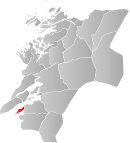Frosta
| Frosta kommune | |||
|---|---|---|---|
| Municipality | |||
 |
|||
|
|||
 Frosta within Nord-Trøndelag |
|||
| Coordinates: 63°36′14″N 10°46′28″E / 63.60389°N 10.77444°ECoordinates: 63°36′14″N 10°46′28″E / 63.60389°N 10.77444°E | |||
| Country | Norway | ||
| County | Nord-Trøndelag | ||
| Administrative centre | Frosta | ||
| Government | |||
| • Mayor (2009) | Frode Revhaug (H) | ||
| Area | |||
| • Total | 76.34 km2 (29.48 sq mi) | ||
| • Land | 74.30 km2 (28.69 sq mi) | ||
| • Water | 2.04 km2 (0.79 sq mi) | ||
| Area rank | 399 in Norway | ||
| Population (2011) | |||
| • Total | 2,538 | ||
| • Rank | 307 in Norway | ||
| • Density | 34/km2 (90/sq mi) | ||
| • Change (10 years) | 4.3 % | ||
| Demonym(s) | Frosting | ||
| Time zone | CET (UTC+1) | ||
| • Summer (DST) | CEST (UTC+2) | ||
| ISO 3166 code | NO-1717 | ||
| Official language form | Neutral | ||
| Website | www |
||
|
|
|||
Frosta is the smallest municipality in Nord-Trøndelag county, Norway. The administrative centre is the village of Frosta. The municipality is located in the Trondheimsfjord, on a peninsula just north of Trondheim. It also includes the island of Tautra which is connected to the mainland by a causeway bridge.
Frosta was established as a municipality on 1 January 1838 (see formannskapsdistrikt). It is one of very few municipalities in Norway with unchanged borders since that date.
The Old Norse form of the name was (also) Frosta. The meaning of the name is unknown. Historically, the name was also spelled Frosten.
The coat of arms was granted in 1987. The arms show a gold sceptre or mace on a green background. The coat-of-arms is inspired by the old seal of the Frostating, where King Magnus VI the law-mender is sitting with a lily sceptre in his hand.
The Church of Norway has one parish (sokn) within the municipality of Frosta. It is part of the Sør-Innherad deanery and the Diocese of Nidaros.
Several rock engraving sites can be found in the parish, together with burial mounds from Viking times. Archaeologists have for the first time found the remnants of a (Vikinghavna på Fånestangen) in Norway at Frosta. A number of logs sticking up along the shoreline at Frosta have been dated back to around year 1000.
...
Wikipedia


